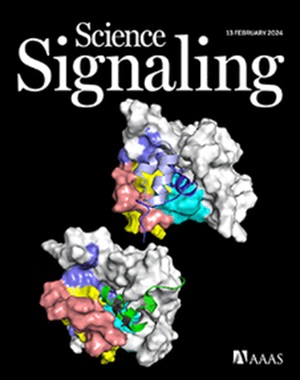Amphiregulin contributes to neuropathic pain by enhancing glycolysis that stimulates histone lactylation in sensory neurons
IF 6.6
1区 生物学
Q1 BIOCHEMISTRY & MOLECULAR BIOLOGY
引用次数: 0
Abstract
The genesis of neuropathic pain after peripheral nerve injury is associated with changes in gene expression and cell metabolism in sensory neurons and the release of inflammatory cytokines. Here, we connected glycolytic metabolism induced by the epidermal growth factor receptor (EGFR) ligand amphiregulin (AREG) to histone lactylation and changes in gene expression that promote chronic neuropathic pain. In both male and female mice subjected to peripheral nerve injury, the mRNA and protein abundance of AREG and its receptor EGFR was increased in dorsal root ganglia (DRGs). AREG-EGFR signaling induced glycolytic metabolism by activating the kinase PKM2. An increase in the glycolytic byproduct lactate facilitated lactylation of the histone lysines H3K18 and H4K12 by the lactyltransferase p300 in DRG neurons. These modifications promoted the expression of genes encoding various proinflammatory and pronociceptive proteins that contribute to the development and maintenance of pain. Deletion or knockdown of AREG or pharmacologically inhibiting EGFR, PKM2, or p300 alleviated neuropathic pain in mice and attenuated the injury-induced hyperexcitability of nociceptive neurons. Targeting this metabolically driven epigenetic mechanism may be a way to treat neuropathic pain in patients.
双调节蛋白促进糖酵解,刺激感觉神经元组蛋白乳酸化,从而促进神经性疼痛
周围神经损伤后神经性疼痛的发生与感觉神经元基因表达和细胞代谢的改变以及炎性细胞因子的释放有关。在这里,我们将表皮生长因子受体(EGFR)配体双调节蛋白(AREG)诱导的糖酵解代谢与组蛋白乳酸化和基因表达变化联系起来,从而促进慢性神经性疼痛。在外周神经损伤的雌雄小鼠中,背根神经节(DRGs)中AREG及其受体EGFR mRNA和蛋白丰度均升高。AREG-EGFR信号通过激活激酶PKM2诱导糖酵解代谢。糖酵解副产物乳酸的增加促进了DRG神经元中组蛋白赖氨酸H3K18和H4K12的乳酸转移酶p300的乳酸化。这些修饰促进了编码各种促炎和前感觉蛋白的基因的表达,这些蛋白有助于疼痛的发展和维持。AREG的缺失或敲低或药物抑制EGFR、PKM2或p300可减轻小鼠的神经性疼痛,并减轻损伤引起的伤害性神经元的高兴奋性。针对这种代谢驱动的表观遗传机制可能是治疗患者神经性疼痛的一种方法。
本文章由计算机程序翻译,如有差异,请以英文原文为准。
求助全文
约1分钟内获得全文
求助全文
来源期刊

Science Signaling
BIOCHEMISTRY & MOLECULAR BIOLOGY-CELL BIOLOGY
CiteScore
9.50
自引率
0.00%
发文量
148
审稿时长
3-8 weeks
期刊介绍:
"Science Signaling" is a reputable, peer-reviewed journal dedicated to the exploration of cell communication mechanisms, offering a comprehensive view of the intricate processes that govern cellular regulation. This journal, published weekly online by the American Association for the Advancement of Science (AAAS), is a go-to resource for the latest research in cell signaling and its various facets.
The journal's scope encompasses a broad range of topics, including the study of signaling networks, synthetic biology, systems biology, and the application of these findings in drug discovery. It also delves into the computational and modeling aspects of regulatory pathways, providing insights into how cells communicate and respond to their environment.
In addition to publishing full-length articles that report on groundbreaking research, "Science Signaling" also features reviews that synthesize current knowledge in the field, focus articles that highlight specific areas of interest, and editor-written highlights that draw attention to particularly significant studies. This mix of content ensures that the journal serves as a valuable resource for both researchers and professionals looking to stay abreast of the latest advancements in cell communication science.
 求助内容:
求助内容: 应助结果提醒方式:
应助结果提醒方式:


